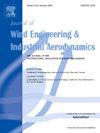A proposed approach for combined wind and temperature loading of power transmission lines considering climate change effect
IF 4.2
2区 工程技术
Q1 ENGINEERING, CIVIL
Journal of Wind Engineering and Industrial Aerodynamics
Pub Date : 2025-02-27
DOI:10.1016/j.jweia.2025.106057
引用次数: 0
Abstract
This paper presents a framework to derive bivariate hazard curves for minimum temperature and maximum concurrent wind speed to characterize the combined wind and temperature loading of power transmission lines. Hazard curves are extracted for mean recurrence intervals (MRIs) of 50, 150, and 500-years, following IEC-60826 standard criteria. The framework employs the Joint Probability-Based Approach (JPBA) and Force-Based Approach (FBA) using numerical sampling of basic meteorological variables from historical data. It incorporates climate change effects by modeling minimum daily temperature trends through SARIMA time series analysis and Neural-Prophet machine learning. Correcting environmental effects is crucial for reliable meteorological simulations and accurate climate change trend capture. Considering climate change at the studied station, the framework shows minimum temperature extremes rise by 5 °C, 3 °C and 1 °C for 500, 150, and 50-year MRIs respectively. It models maximum daily wind speed probability distributions with monthly parameter variations. Simulations over 5000 years produce hazard curves based on JPBA and FBA and comparisons with IEC-60826 standard loading cases indicate conservative estimates in the JPBA-based approach. The IEC-60826 standard's first loading case for the 50 and 150-year MRIs is lower than the FBA-based hazard curves for all spans, with increasing underestimation as span length decreases.
一种考虑气候变化影响的输电线路风温联合负荷方法
本文提出了一种推导最小温度和最大并发风速的二元危险曲线的框架,以表征输电线路的风温复合负荷。按照IEC-60826标准,提取了50年、150年和500年的平均复发间隔(mri)的危险曲线。该框架采用基于概率的联合方法(JPBA)和基于力的联合方法(FBA),从历史数据中对基本气象变量进行数值抽样。它通过SARIMA时间序列分析和Neural-Prophet机器学习建模最低日温度趋势,从而结合了气候变化的影响。纠正环境影响对于可靠的气象模拟和准确捕捉气候变化趋势至关重要。考虑到研究站的气候变化,框架显示500年、150年和50年核磁共振成像的最低极端温度分别上升了5°C、3°C和1°C。它模拟了逐月参数变化的最大日风速概率分布。基于JPBA和FBA的5000年模拟得出了危险曲线,并与IEC-60826标准加载情况进行了比较,表明基于JPBA方法的估计是保守的。IEC-60826标准对50年和150年核磁共振成像的首次加载情况低于基于fba的所有跨度的危险曲线,随着跨度长度的减小,低估的程度越来越高。
本文章由计算机程序翻译,如有差异,请以英文原文为准。
求助全文
约1分钟内获得全文
求助全文
来源期刊
CiteScore
8.90
自引率
22.90%
发文量
306
审稿时长
4.4 months
期刊介绍:
The objective of the journal is to provide a means for the publication and interchange of information, on an international basis, on all those aspects of wind engineering that are included in the activities of the International Association for Wind Engineering http://www.iawe.org/. These are: social and economic impact of wind effects; wind characteristics and structure, local wind environments, wind loads and structural response, diffusion, pollutant dispersion and matter transport, wind effects on building heat loss and ventilation, wind effects on transport systems, aerodynamic aspects of wind energy generation, and codification of wind effects.
Papers on these subjects describing full-scale measurements, wind-tunnel simulation studies, computational or theoretical methods are published, as well as papers dealing with the development of techniques and apparatus for wind engineering experiments.

 求助内容:
求助内容: 应助结果提醒方式:
应助结果提醒方式:


